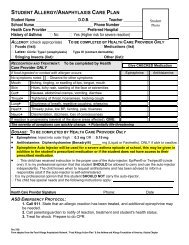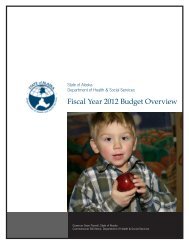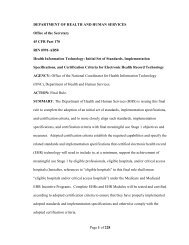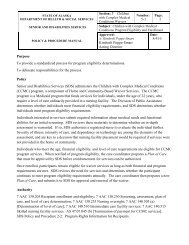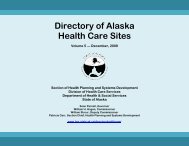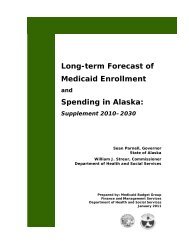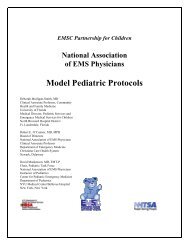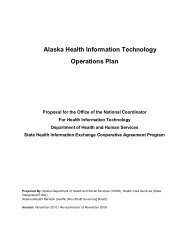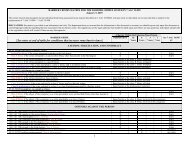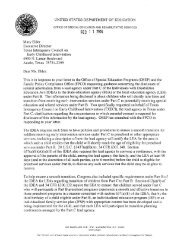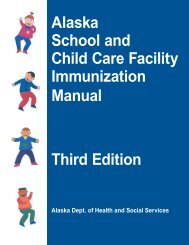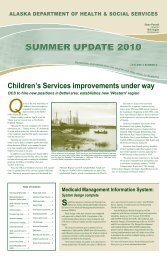Long-term Forecast of Medicaid Enrollment Spending in Alaska:
Long-term Forecast of Medicaid Enrollment Spending in Alaska:
Long-term Forecast of Medicaid Enrollment Spending in Alaska:
Create successful ePaper yourself
Turn your PDF publications into a flip-book with our unique Google optimized e-Paper software.
Summary<br />
<strong>in</strong> later years 10. The special payments are represented <strong>in</strong> this forecast by add<strong>in</strong>g<br />
an additional 7 percent onto the forecast, based on claims data. In any given year,<br />
the forecast assumes that the share <strong>of</strong> total spend<strong>in</strong>g paid by the federal<br />
government will be the same for these special payments as it was for the claims<br />
payments.<br />
Summary<br />
Total spend<strong>in</strong>g is forecast to reach $3.6 billion by 2029 (see Table 6), grow<strong>in</strong>g at<br />
an average annual rate <strong>of</strong> 5.8 percent. State spend<strong>in</strong>g is expected to grow at 6.8<br />
percent. Aside from <strong>in</strong>flation, growth <strong>in</strong> total spend<strong>in</strong>g through 2029 is primarily<br />
the result <strong>of</strong> the follow<strong>in</strong>g factors:<br />
Population growth – expected to average 0.9 percent per year<br />
<strong>Enrollment</strong> growth – expected to average 1.1 percent per year<br />
The population forecast <strong>in</strong>cludes assumptions about the chang<strong>in</strong>g demographic<br />
pr<strong>of</strong>ile <strong>of</strong> <strong>Alaska</strong>. The average annual growth rate <strong>in</strong> enrollment <strong>of</strong> the elderly (65<br />
and older) is expected to be 5.1 percent, which is higher than the growth rate for<br />
other age groups. As a result, the overall focus <strong>of</strong> the <strong>Medicaid</strong> program will shift<br />
from a child-based program to a program more evenly distributed between<br />
children, work<strong>in</strong>g-age adults, and the elderly. This demographic change affects<br />
spend<strong>in</strong>g because spend<strong>in</strong>g on the elderly is grow<strong>in</strong>g at a rate almost double that<br />
<strong>of</strong> children and work<strong>in</strong>g-age adults, and this growth is likely to cont<strong>in</strong>ue. The<br />
expected shift <strong>in</strong> spend<strong>in</strong>g towards the elderly is still likely to occur, but the<br />
tim<strong>in</strong>g is delayed compared to earlier forecasts.<br />
Services used more heavily by the elderly, such as Personal Care and Home and<br />
Community Based Waivers, will experience the highest spend<strong>in</strong>g growth<br />
throughout the forecast period.<br />
The purpose <strong>of</strong> this forecast is to enable policy makers and Health and Social<br />
Services executives to see where <strong>Medicaid</strong> is headed based on key growth<br />
components. By look<strong>in</strong>g farther <strong>in</strong>to the future, policy can be based more on<br />
proactive rather than reactive measures.<br />
10 FairShare and ProShare are two examples <strong>of</strong> supplemental payment programs that have been<br />
discont<strong>in</strong>ued <strong>in</strong> recent years.<br />
<strong>Long</strong> Term <strong>Forecast</strong> <strong>of</strong> <strong>Medicaid</strong> <strong>Enrollment</strong> and <strong>Spend<strong>in</strong>g</strong> <strong>in</strong> <strong>Alaska</strong>: 2009‐2029<br />
21



